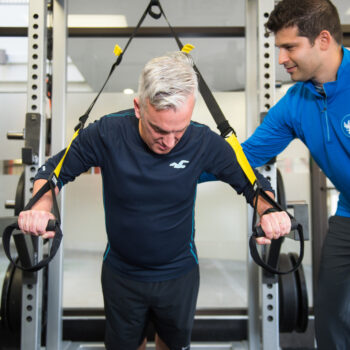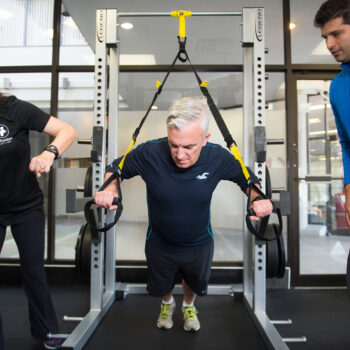If you’ve spent any length of time in the arena of health, fitness and personal training, you likely may have encountered the concept of protein supplements, from powders and smoothies, to bars and cookies, how do we know if we’re getting enough? The marketing tells us that we might need to get more for better results, and while protein is an important building block for our bodies, over/under consumption might impact our health.
Protein – So what’s the scoop?
By Andrea Cheung
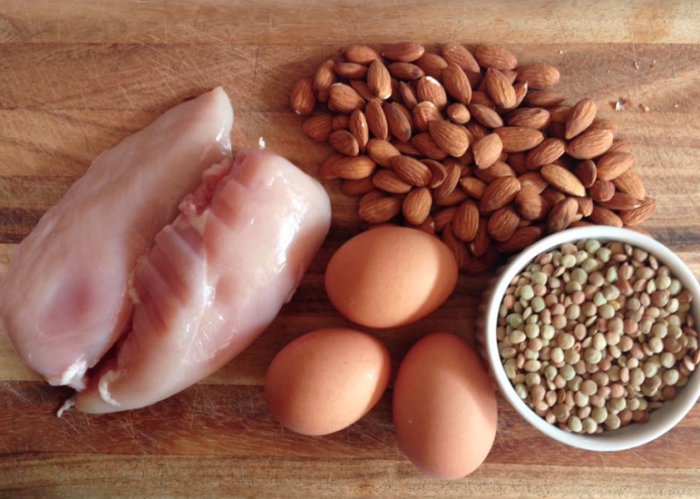
What are proteins?
Proteins are organic molecules composed of a folded chain of amino acids. These amino acids are the building block for tissue repair and growth, and produce other important molecules to help the body with regulation, such as hormones. At the same time, it is an energy-yielding nutrient when carbohydrates run out in our body.
How much protein do I need?
The amount an individual requires depends on a few factors, two of which are your current weight and your activity level. If you have that information, calculating how much protein you need is easy as steak and kidney pie (or rice and bean pie?).
Body weight (kilograms) x activity modifier = daily protein intake (in grams)
- Sedentary: 0.8g/kg body weight
- Light activity (workout 1-2 days/week): 1.0-1.2g/kg body weight
- Moderately activity (workout 3-4 days/week): 1.2-1.5g/kg body weight
- Vigorously activity (workout ?5 days/week): 2.0g/kg body weight
- Older adults (over age 65) should consume at least 1.2g/kg body weight to maintain muscle mass
Here are some examples:
(1) New exercises in her 40s who works as an office clerk, does some house work, walks a couple times a week. She 55kg
Light activity level: 55kg x 1.0-1.2g/kg = 55-66g protein/day
(2) Athlete who weight trains 5 days/week. He is 160lb (72.7kg)
Vigorous activity level: 72.7kg x 2.0g/kg = 145.4g protein/day
(3) Individual in their 70s who swims 2x per week in the pool and weighs 68kg
Light activity: 68kg x 1.0-1.5g/kg* = 68-102g protein/day
*While they are categorized as light activity, and in their 70s, this person should consume more protein to retain his muscle mass.
When someone becomes more active, such as participating in high intensity exercise most days, the body actually breaks down more protein in order to rebuild the tissues such as muscle fibres to accommodate the additional stresses on the system, and sufficient dietary protein can help retain muscle mass.
Special considerations:

Aging adults should also consume 1.2 – 2.0g/kg body weight protein daily, as this population is less responsive to low doses of amino acid intake. However, we should keep in mind that more than 2.0g/kg body weight protein for a period of time can cause health problems.
Pregnant and lactating people are also recommended to have a bit more protein due to the metabolic demands of pregnancy and lactation. So for example, a non-active individual is recommended 0.88 grams to 1.1 grams per kilogram of body weight per day.
Is it possible to have TOO MUCH protein?
Some fitness myths push protein so much, that some newly active individuals will overconsume protein and often associated with that, is additional calories that are not needed by the body, resulting in extra weight gain, as the calories from protein are stored as body fat. Of course that are some individual that have goals of increasing body mass and when it is a deliberate strategy to achieve their goals, great. Just don’t fall into the trap of thinking more protein = more muscle without all the factors considered.
From a health standpoint, protein over consumption has been correlated to kidney stone formation due to increase in urinary acidity. If we over consume red meat that is high in saturated fat, there is an increasing risk in coronary heart disease due to lipids disposed in blood vessels.
Individuals with kidney or liver disease are advised to lower protein intake due to stress on their systems. Doctors recommend 0.6-0.8 grams / kg of body weight.
But am I getting enough protein?
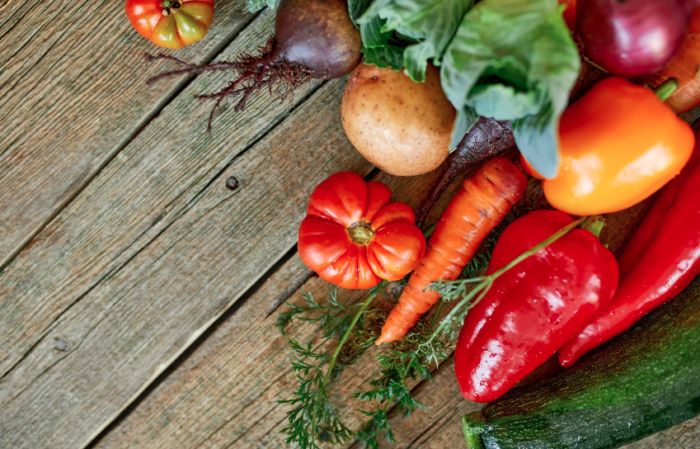
While protein under consumption is not as common in North America, this does happen occasionally in elderly due to loss of appetite.
Another population that may be at risk of underconsumption are people new to vegan or vegetarianism that have cut out meat and meat products without making adjustments to their diet. Thankfully, it’s not difficult for plant-based eaters to get enough protein! Beans, nuts, seeds, and legumes are high in protein that will meet your daily protein requirement. We will talk about it in the next section.
Without adequate protein, adults will face muscle loss and increase risk of developing sarcopenia, an age related involuntary loss of muscle mass and strength. Evidence suggests that individuals that might be classified “at risk” of having not enough protein, should have closer to 1.2-1.5g/kg body weight daily to help increase muscle mass and strength. Strength training programs such as resistance training will aid in muscle maintenance combined with sufficient protein intake
How to estimate the amount protein in my meal?
Obviously if you can get yourself a fancy scale that can get you a decimal point or two in gram measurements, we recommend a digital scale, if exact numbers are important to you. However if you’re just starting out and don’t have a scale, the best option is to use the palm of your hand as a guide.
A serving of protein (15-30g) for something like a steak or chicken breast is around palm size, where 2 servings per meal will be optimal for the general population. For example, a 50 kg individual will need 50g of protein per day, then 2-3 palm sizes of protein will satisfy the minimal protein intake for the day.
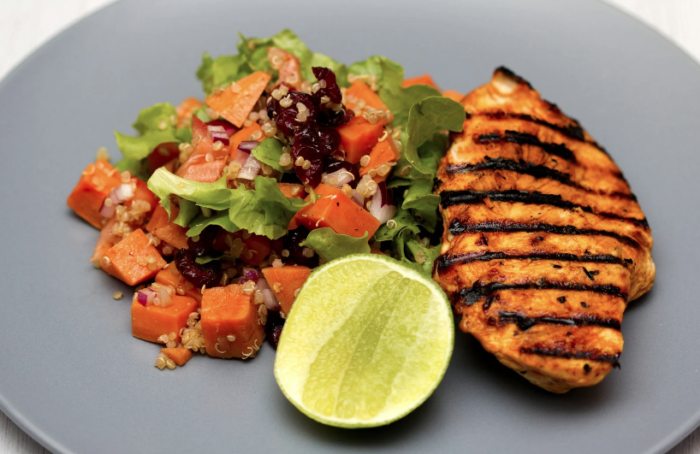
Here are a few examples of a serving of protein:
- 3 large eggs
- 100g of chicken breast
- 200mL (1 cup) of greek yogurt
- 2 ½ cup of Cooked quinoa
- 300g of Firm Tofu
Research also recommends spreading your proteins in each meal rather than finishing it in one meal. This provides better absorption and reduces the amount of excess protein being oxidized for energy use. To build muscle, experts recommend the best time is within 2 hours after your resistance training with a mix of carbohydrates for optimal results. Having a small amount of protein 1-2 hours before workout can also kick start muscle synthesis. However, if you forgot to have protein pre- or post-workout, no worries! As long as you have sufficient protein throughout the day, you will still get the benefit of protein on muscle synthesis.
What’s a complete protein?
Complete protein food sources mean that item has a full complement of 9 essential amino acids, which our bodies don’t make. Just for your trivia night, these are: histidine, isoleucine, leucine, lysine, methionine, phenylalanine, threonine, tryptophan, and valine. Items like fish, eggs, dairy products, steak and soy products are considered complete.
Items like nuts, whole-grains, seeds and legumes are high in protein, they are considered “incomplete.” So for individuals that have a plant-based diet, they’ll need to consider having a variety of foods in combination in order to create a complete protein.
Here are some some sample combinations:
- Black beans + corn (legume & grains)
- Chickpeas + sesame seeds (legumes & seeds)
- Kidney beans + cashews (Legume & nuts)
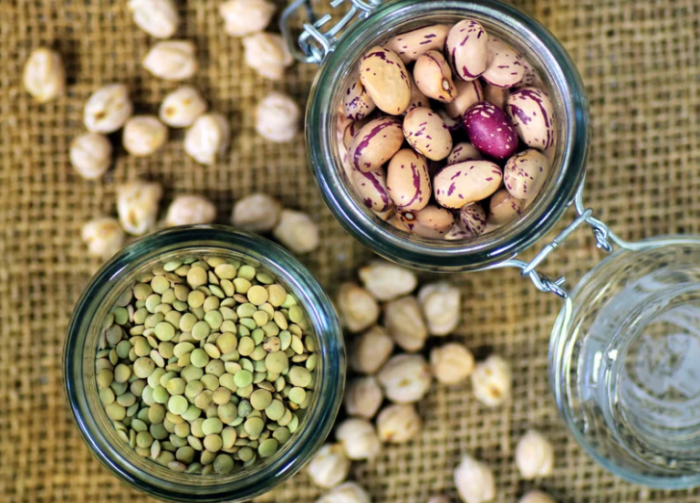
You don’t have to combine legumes with grains, nuts, or seeds to form“complete protein, into a single meal. As long as you eat a variety of whole foods during the day, this will not impact whether the food is an incomplete protein.
Is there a “BEST” protein to eat for health minded people?
Canada’s food guide recommends to choose protein foods that come from plants as they are high in fibre and low in saturated fat. Some options are tofu, tempeh, and edamame (all considered complete protein, too!). The food guide also recommends lean sources of protein such as fish and shellfish. Chicken of the sea and sushi not your favourites? That’s okay, you can prioritize white lean meat (chicken) over red meat (steak). This is because red meat tends to have higher saturated fat content, which may contribute to heart disease. You may also consume milk and dairy products that are unsweetened and low in fat.
Here are some common foods that you consume and the amount of protein it contains:
- 1 large egg: 6g
- 1 tsp peanut butter: 4g
- 100g broccoli: 2.8g
- Medium size corn: 3g
- One Timbits: 1g
- One bagel: 10g
If you would like to know more about which types of foods are high in protein, here is the link for you to find out more!
But if I eat more protein, I’ll have more muscle, right?
There is a long standing myth that consuming protein will create muscle growth. While this is not totally wrong, muscle growth requires 3 major mechanisms – muscle tension, muscle damage, and metabolic stress. These stresses AND adequate proteins will then promote muscle growth. Therefore, without any stresses from resistance training, consuming more protein will not benefit us from gaining muscle mass. Rather, we may end up over-consuming protein that impacts our health. Look forward to our next blog about signs and symptoms and risk of protein overconsumption to our health!
References:
- Canada’s food guide: https://food-guide.canada.ca/en/healthy-eating-recommendations/make-it-a-habit-to-eat-vegetables-fruit-whole-grains-and-protein-foods/eat-protein-foods/
- Protein consumption and elderly: https://www.ncbi.nlm.nih.gov/pmc/articles/PMC4924200/
 With a passion for an active and healthy lifestyle (especially swimming), Andrea is pursuing a degree in Kinesiology to with the goal of having a positive impact on people’s health.
With a passion for an active and healthy lifestyle (especially swimming), Andrea is pursuing a degree in Kinesiology to with the goal of having a positive impact on people’s health.




